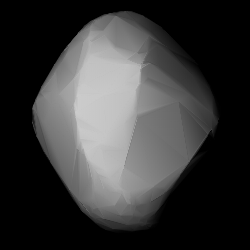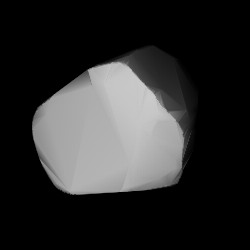2934 Aristophanes, provisional designation 4006 P-L, is a carbonaceous Veritasian asteroid from the outer regions of the asteroid belt, approximately 22 kilometers in diameter. It was discovered during the Palomar–Leiden survey in 1960, and later named after ancient Greek dramatist Aristophanes.

92 Undina is a large main belt asteroid. The asteroid was discovered by Christian Peters on 7 July 1867 from the Hamilton College Observatory. It is named for the eponymous heroine of Undine, a popular novella by Friedrich de la Motte Fouqué.

212 Medea is a very large main-belt asteroid that was discovered by Johann Palisa on February 6, 1880, in Pola, and was named after Medea, a figure in Greek mythology.
259 Aletheia is a very large main-belt asteroid that was discovered by German–American astronomer Christian Peters on June 28, 1886, at Litchfield Observatory, Clinton, New York. The dark and heterogeneously composed X-type asteroid contains primitive carbonaceous materials, responsible for its low albedo of 0.04. Aletheia measures about 185 kilometers in diameter and belongs to the largest asteroids of the main-belt. It has a semi-major axis of 3.1 AU and an orbit inclined by 11 degrees with a period of 5.55 years.
363 Padua is a main belt asteroid that was discovered by Auguste Charlois on 17 March 1893 in Nice. It was named after the city of Padua, near Venice, Italy.

413 Edburga is a typical Main belt asteroid. Max Wolf discovered it on 7 January 1896 at Heidelberg Observatory. The origin of the name is unknown. This asteroid is orbiting the Sun at a distance of 2.58 AU with a period of 4.15 yr and an eccentricity of 0.34. Its orbital plane is inclined at an angle of 18.7° to the plane of the ecliptic.
460 Scania is a background asteroid and a slow rotator from the central regions of the asteroid belt. It was discovered by German astronomer Max Wolf at the Heidelberg-Königstuhl State Observatory on 22 October 1900. The uncommon K-type asteroid has an exceptionally long rotation period of 164.1 hours and measures approximately 21 kilometers in diameter. It was named after the Swedish region of Scania, where a meeting was held by the Astronomische Gesellschaft in 1904.
716 Berkeley is a background asteroid from the central regions of the asteroid belt. It was discovered by Austrian astronomer Johann Palisa at the Vienna Observatory on 30 July 1911. The stony S-type asteroid has a rotation period of 15.6 hours and measures approximately 21 kilometers in diameter. It was named after the city of Berkeley, California, where the discoverer's colleague Armin Otto Leuschner (1868–1953) was the director of the local observatory.

720 Bohlinia is a minor planet orbiting the Sun that was discovered by Franz Kaiser, a German astronomer in 1911. It is named for Swedish astronomer Karl Petrus Theodor Bohlin, to mark his 65th birthday. He had worked on the orbits of asteroids.
735 Marghanna is a large carbonaceous background asteroid from the central regions of the asteroid belt, approximately 74 kilometers in diameter. It was discovered on 9 December 1912, by German astronomer Heinrich Vogt at the Heidelberg-Königstuhl State Observatory in southwest Germany. The dark C-type asteroid (Ch) has a rotation period of 20.6 hours and is rather regular in shape. It was named after Margarete Vogt and after Hanna, the mother and a relative of the discoverer, respectively.
774 Armor is a minor planet orbiting in the main belt. It was discovered on 13 December 1913, in Paris by French astronomer Charles le Morvan and was named after the Celtic region of Armorica. The asteroid is orbiting at a distance of 3.05 AU with a period of 5.32 yr and an eccentricity of 0.169. The orbital plane is inclined by an angle of 5.56° to the plane of the ecliptic.

776 Berbericia is a minor planet orbiting the Sun. A main-belt C-type asteroid, it was discovered on 24 January 1914 by astronomer Adam Massinger at Heidelberg Observatory in southwest Germany. It was named by Max Wolf in honor of Adolf Berberich (1861–1920), a German astronomer. The spectra of the asteroid displays evidence of aqueous alteration.
865 Zubaida is an elongated, stony background asteroid from the inner regions of the asteroid belt. It was discovered on 15 February 1917, by astronomer Max Wolf at the Heidelberg Observatory in southwest Germany, and given the provisional designations A917 CH and 1917 BO. The uncommon L-type asteroid has a rotation period of 11.4 hours and measures approximately 17 kilometers in diameter. It was named after Zobeide, a character in the opera Abu Hassan by Carl Maria von Weber (1786–1826).

961 Gunnie is a very dark background asteroid from the central regions of the asteroid belt, approximately 37 kilometers in diameter. It was discovered on 10 October 1921, by German astronomer Karl Reinmuth at the Heidelberg-Königstuhl State Observatory. The C/X-type asteroid has a rotation period of 21.4 hours. It was named after Gunnie Asplind, daughter of Swedish astronomer Bror Asplind (1890–1954).
1181 Lilith is a metallic asteroid from the middle region of the asteroid belt, approximately 23 kilometers in diameter. It was discovered on 11 February 1927, by Russian–French astronomer Benjamin Jekhowsky at Algiers Observatory in Algeria, Northern Africa, and named after French composer Lili Boulanger.
3063 Makhaon is a large Jupiter trojan from the Greek camp, approximately 114 kilometers in diameter. It was discovered on 4 August 1983, by Soviet astronomer Lyudmila Karachkina at the Crimean Astrophysical Observatory in Nauchnij, on the Crimean peninsula. The dark D-type asteroid is the principal body of the proposed Makhaon family and belongs to the 20 largest Jupiter trojans having a rotation period of 8.6 hours. It was named after the legendary healer Machaon from Greek mythology.
3141 Buchar, provisional designation 1984 RH, is a dark Cybele asteroid from the outermost region of the asteroid belt, approximately 36 kilometers in diameter. It was discovered on 2 September 1984, by Czech astronomer Antonín Mrkos at the Kleť Observatory. The D-type asteroid has a rotation period of 11.4 hours. It was named in memory of Czechoslovakian astronomer Emil Buchar.

5196 Bustelli is a stony Eunomia asteroid from the central regions of the asteroid belt, approximately 6 kilometers kilometers in diameter. It was discovered on 30 September 1973, by Dutch astronomers Ingrid and Cornelis van Houten at Leiden, and Tom Gehrels the Palomar Observatory. The S-type asteroid was named after Italian-Swiss artist Franz Anton Bustelli.
1759 Kienle, provisional designation 1942 RF, is a stony background asteroid from the central regions of the asteroid belt, approximately 7 kilometers in diameter. It was discovered on 11 September 1942, by astronomer Karl Reinmuth at the Heidelberg-Königstuhl State Observatory in southwest Germany. The S-type asteroid has a longer-than average rotation period of 29.3 hours. It was named for German astrophysicist Hans Kienle.
2301 Whitford, provisional designation 1965 WJ, is a background asteroid from the outer regions of the asteroid belt, approximately 17 kilometers in diameter. It was discovered on 20 November 1965, by astronomers of the Indiana Asteroid Program at Goethe Link Observatory in the United States. The asteroid was named for American physicist and astronomer Albert Whitford. The uncommon L-type asteroid has a rotation period of 14.3 hours.







